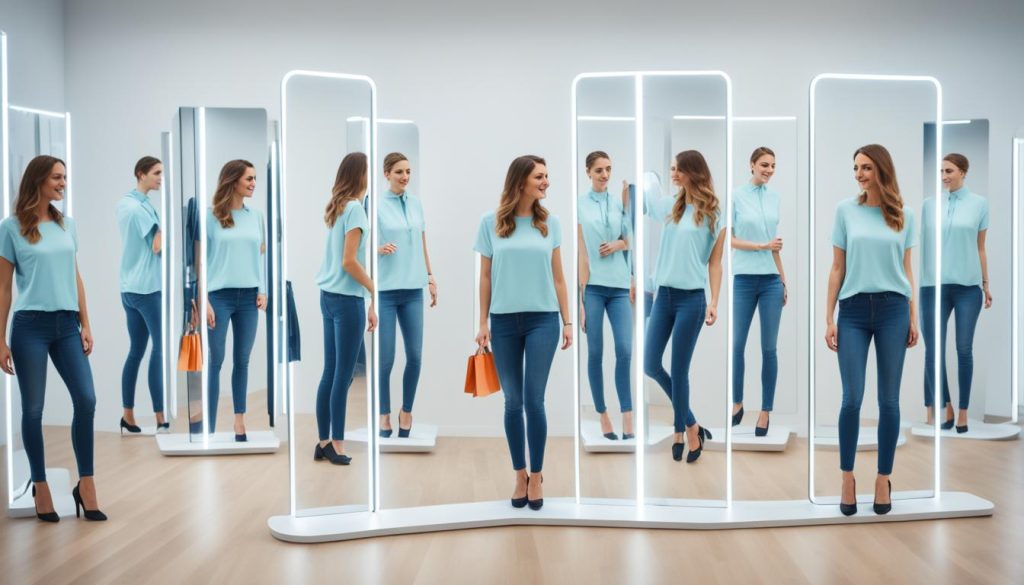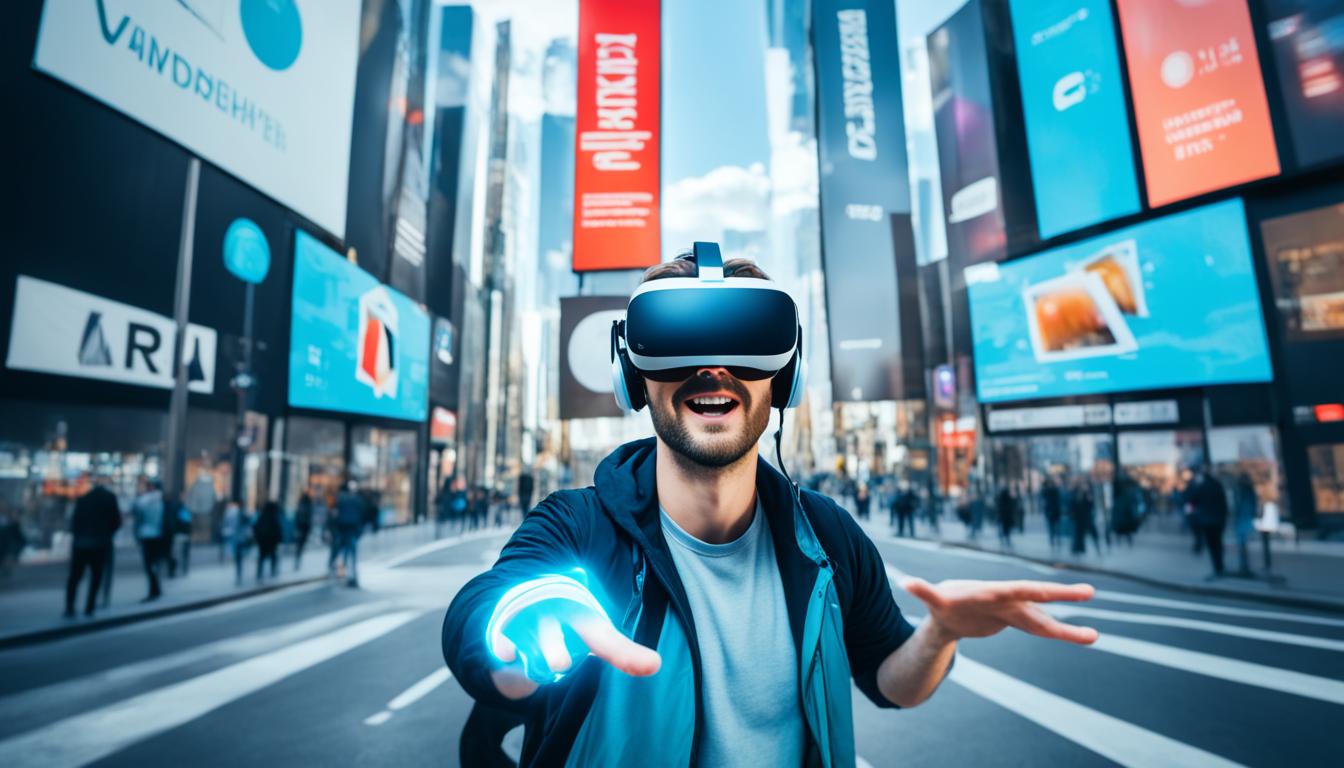Imagine a world where physical and digital boundaries fade, ushering us into a future where Augmented and Virtual Reality dominates our daily lives. In this new era defined by Immersive Technologies, boundaries between real and virtual spaces vanish. Humanity finds itself in a redefined environment for work, play, and connection.
AR/VR is doing more than just changing the face of entertainment. It is revolutionizing the way we approach and conduct business. Envision a scenario where you wear sleek devices that enhance your reality, opening doors to virtual worlds. This reality, now a part of our lives, is fuelled by Extended Reality (XR) and sophisticated Artificial Intelligence.
Digital Interactions through AR and VR are quickly becoming the focal point of technological evolution. These technologies are creating deeper engagement and shaping our understanding of the world around us. Join us as we explore the limitless potential of augmented and virtual realities, as well as the bright future they hold for us.
The Transformative Journey of Augmented and Virtual Reality
The world of immersive technologies has evolved rapidly from early innovation to high-tech applications. Augmented and virtual reality (AR/VR) have seen substantial growth due to technological advancements. These have paved the way for a future deeply entrenched in digital experiences.
From Sensorama to Smart Glasses: Tracing the Evolution in Immersive Tech
Morton Heilig’s Sensorama, invented in the 1960s, introduced a multi-sensory cinema experience. It was an early form of what we know as virtual reality today. Ivan Sutherland’s development of the first head-mounted display shortly after marked a turning point. These efforts were foundational, pushing the boundaries towards more engaging virtual experiences.
Key Milestones That Shaped the Current AR/VR Landscape
Gesture recognition and advanced 3D visuals marked significant progress in immersive tech. Over the years, various milestones shaped the field, leading to more realistic mixed reality environments. Today, we see the result of this progress in the form of AR smart glasses and advanced VR tools. This technology comes with enhanced accessibility and user-friendly interfaces, enabling richer digital experiences.
These breakthroughs have not only changed how we engage with digital content but have also integrated immersive tech into our daily lives. They have significantly impacted industries like gaming and education, showcasing the true power of AR/VR.
The ongoing evolution of AR/VR is a story of human creativity and the desire to surpass limitations in digital interaction. It stands as evidence of our continuous journey towards more immersive and engaging digital experiences.
Augmented and Virtual Reality
The lines between the digital and physical world are fading fast. Augmented Reality (AR) and Virtual Reality (VR) grow more advanced. Driven by new Human-Computer Interaction and AR/VR tech, these two change how we see and understand reality.
Breaking Down the Basics: What are AR and VR?
AR and VR bring different things to the table but both make our experiences richer. Virtual Reality puts users in a completely different world. This world is fabricated and digital, offering a unique simulation. Augmented Reality adds a layer of digital info on top of our real world. It uses technology like Gesture Recognition to mix data and graphics with reality.
The Synergy of Real and Virtual Worlds Through Mixed Reality
Mixed Reality combines AR and VR, blending digital and physical realities. It allows digital and physical to work together seamlessly. This merging boosts Gesture Recognition, making interactions feel natural whether you’re in a simulated or augmented world.
The Technology Behind AR/VR: Exploring Spatial Computing
Spatial Computing is leading in making human-computer interactions smoother and more natural in AR and VR. This technology interprets and reacts to the physical world in a digital way. It makes our experiences both practical and immersive. The heart of it is in how it bridges the gap between the real and digital worlds through advanced AR and VR.
Spatial Computing also makes Simulation Environments more than just visually stunning. They become interactive and responsive to the user’s movements and gestures. This makes using AR and VR feel as natural as the real world, lessening the burden on our minds during interactions.
| Technology | Role in AR/VR | Benefits |
|---|---|---|
| Gesture Recognition | Interprets user movements | Enhanced interaction |
| AR/VR Integration | Merges digital and real-world elements | Seamless experiences |
| Spatial Computing | Processes spatial relationships | Intuitive environments |
These techs work together to change the game in AR and VR. They lead us to more immersive and intuitive experiences in the future.
Industries Revolutionized by Immersive Technologies
The advent of augmented reality (AR) and virtual reality (VR) has sparked a sea change across numerous sectors. They are seen not just as supplementary tools but as essential drivers of innovation and customer experience enhancement. Their impact is transformative.
In the Education Sector, AR and VR are forging ahead with novel teaching techniques. They’re making learning much more interactive and captivating. These technoloies enable students to explore complex ideas in 3D, improving comprehension and memory. The Healthcare Industry, too, is using AR to boost the precision of surgeries and training. It overlays crucial patient data in real-time, greatly aiding medical professionals.
The story is similar in the E-commerce arena. AR allows for virtual try-ons and detailed product views, changing the way we shop online. This has led to happier customers and fewer returns. The Entertainment Industry is capitalizing on VR for its ability to craft vast, immersive realms. By doing so, it offers unique escape avenues through games, live events, and virtual tours.
Remote Work Solutions are benefiting greatly from VR as well. It creates a digital, interactive workspace that simulates physical work environments. This is making global team efforts smoother and more productive.
- Education Sector: Interactive 3D learning experiences
- Healthcare Industry: Enhanced surgical accuracy with real-time data overlays
- E-commerce: Virtual try-ons and detailed product previews
- Entertainment Industry: Immersive gaming and virtual concerts
- Remote Work Solutions: Virtual offices and meeting rooms
AR and VR are more than advancements in existing technology. They herald the dawn of new possibilities in their respective fields. Companies are not only adapting to digital shifts but are also leading the charge in innovation and customer experience enhancement.

The Rise of Spatial Computing and Its Impact on AR/VR Experiences
Advanced technologies have opened the door to a new level of immersion with spatial computing at their core. This tech makes our interactions feel human-like. It doesn’t just improve user experience, it revolutionizes AR/VR integration.
Understanding Spatial Computing: A Core Principle of Immersive Tech
Spatial Computing is the bridge between virtual and real worlds. It seamlessly mixes them for immersive experiences. This advancement is crucial for making digital actions more natural and real to us.
Case Studies: How Spatial Computing is Amplifying AR/VR Solutions
The impact of AR/VR, backed by spatial computing, is evident across many sectors. These examples highlight how merging real-world physics with the virtual world changes the game. Users can now experience interactive, immersive scenarios previously unthinkable.
| Industry | Application | Impact |
|---|---|---|
| Automotive | Virtual Showrooms | Enhanced customer engagement through virtual car tours and customization features |
| Real Estate | Virtual Property Tours | Remote viewing of properties, boosting convenience and saving time |
| Education | Interactive Learning Environments | Students engage in lifelike simulations, improving understanding and retention |
The examples in the table highlight how Mixed Reality is changing experiences in various fields. From exploring cars in virtual reality to viewing properties remotely, spatial computing with AR/VR enhances interaction with both worlds, setting a new norm.
Artificial Intelligence Enhancing AR and VR Personalization
AI-driven tools are changing the game in augmented and virtual reality. They provide a tailored experience by gathering data from interactions. This data is then used to offer personalized content, improving engagement and the user’s immersion.
By combining AI with AR and VR, businesses can now create unique experiences. Adaptive learning ensures the systems continually get better, anticipating user preferences. This leads to experiences that feel custom-made for each user.
These AI tools enable businesses to craft captivating, user-centric experiences. By analyzing user data, they can suggest content that deeply resonates with every individual. The approach involves complex AI algorithms, aiming for a personal touch in recommendations.
The table showcases how AI’s personalization affects user engagement in AR and VR. It highlights the role of adaptive learning and personalized content in AI-driven experiences.
| Feature | Without AI | With AI |
|---|---|---|
| User Engagement | Basic | Enhanced by personalized experiences |
| Learning Efficiency | Generalized | Adaptive to individual learning pace and style |
| Content Relevance | Static | Dynamic, based on user preferences and history |
By strategically utilizing AI, businesses can both stand out and make a lasting impression. They provide engaging experiences that feel deeply personal.
Healthcare’s Digital Transformation via Augmented Reality
Augmented Reality (AR) is revolutionizing how we approach healthcare. By making healthcare more accessible and improving patient data management, it drives the evolution of interactive care environments. In these new settings, medical professionals and patients alike find benefit in advanced AR solutions.
AR in Surgery: Assisting Surgeons with Overlay Visuals
AR is now a tool in the hands of surgeons, offering a new layer of precision in the operating room. With vital patient data overlaid onto their vision, these professionals operate with a level of certainty not possible before. This reduces errors, increases confidence, and contributes to better patient outcomes.
Consumer Health Empowerment Through AR Applications
AR is empowering consumers in their health journey with its interactive applications. These tools include everything from self-diagnostic options to constant health monitoring, greatly enhancing patient involvement and personal health management.

| Feature | Impact on Medical Practice | Impact on Patients |
|---|---|---|
| Real-time Data Overlay | Enhances surgical precision | Increases understanding of one’s own medical procedures |
| Health Monitoring | Allows for better patient management | Empowers patients to manage their health proactively |
| Self-diagnostic Tools | Reduces the strain on medical facilities | Provides immediate, actionable health insights |
Innovative Learning and Educational Frontiers with VR
The rise of Virtual Classrooms driven by advanced Education Technology is reforming the traditional educational landscape. It introduces students to Interactive Study in immersive settings. This approach not only aids in understanding but also in remembering complex material. By leaning on Experiential Learning, education is crossing into uncharted territories.
In the evolution of Education Technology, VR’s importance has shifted from being optional to vital. Educational institutions worldwide are adopting VR to enable Virtual Classrooms and Interactive Study sessions. These tools mimic real-life situations and encourage the application of knowledge in a safe environment, filling the void between theory and practice.
Table: Impact of VR on Learning Outcomes
| Feature | Benefits | Examples |
|---|---|---|
| Virtual Labs | Hands-on practical experience without physical resource constraints | Chemistry experiments, Physics simulations |
| Immersive History Lessons | Engaging storytelling through historical reenactments | Ancient civilizations, World Wars |
| Language Immersion | Accelerated language learning in native-speaking environments | French in Paris, Spanish in Barcelona |
VR’s impact extends beyond educational content delivery; it’s transforming the learning approach itself. With Immersive Learning that ensures profound understanding and Experiential Learning that boosts interaction, VR stands at the educational revolution forefront. This model prioritizes understanding over memorization and active engagement over passive learning.
Immersive Retail and Shopping Experiences Powered by AR
The advent of augmented reality (AR) has transformed how users interact with products pre-purchase. With advanced AR, consumers can engage in immersive shopping, featuring virtual try-ons and interactive product demos. These innovations are reshaping the retail environment.
The New Era of Virtual Try-Ons and Interactive Product Demonstrations
Virtual try-ons have significantly impacted the fashion and beauty sectors. They allow customers to see products on personalized avatars matching their specific measurements. This boosts user contentment and diminishes the need for returns. Likewise, interactive demos enable customers to thoroughly inspect a product’s properties. This includes electronics, furniture, and vehicles, providing prospective insights beyond what’s possible in traditional retail settings.
Fostering Consumer Engagement: How Retailers are Using AR to Enhance Shopping
AR is pushing the boundaries of retail innovation by not just enhancing user experiences but also increasing customer engagement. Stores now offer experiences that are both immersive and interactive, thereby blending information with enjoyment. Through the incorporation of AR into their strategies, retailers are collecting essential consumer data. This data helps improve inventory management as well as design personalized marketing campaigns.
AR is especially transforming brick-and-mortar stores by combining the benefits of physical shopping with online convenience. The inclusion of features like virtual fitting rooms and aisle navigation tools has rejuvenated retail innovation. This has resulted in more foot traffic and lengthier engagements at physical stores.
| Feature | Benefits | Example Applications |
|---|---|---|
| Virtual Try-Ons | Enhanced shopping experience, reduction in returns, personalized fitting | AR mirrors in fashion stores, Online cosmetics sampling |
| Product Demonstrations | Detailed product interaction, higher confidence in purchase decisions | Interactive AR displays for electronics, 3D visualization of furniture settings |
| Consumer Analytics | Improved consumer insight, targeted marketing | Data analytics tools measuring product interactions and preferences |
By integrating AR technologies, retail is evolving into more engaging and higher standards. It is aligning with the rising consumer expectations in our digital era.
Immersive Entertainment: Virtual Reality Taking Center Stage
The realm of entertainment technology is radically changing, thanks to VR films and immersive storytelling. They are introducing a novel way for audiences to connect, placing interactive narratives as digital entertainment’s spearhead. In Virtual Reality (VR), you don’t just watch a story; you become part of it. This deepens the experience in ways that traditional media simply cannot.
Entertainment has shifted from watching to actively shaping stories. Interactive narratives enable choices that alter the tale, offering a unique journey for every viewer. This feature not only boosts engagement but also adds layers to the story, turning it into a multifaceted experience.
VR films leverage immersive storytelling to provoke intense feelings and a strong sense of being there. These techniques draw viewers in closer, making the interaction feel more real. It’s changing how we view entertainment, merging fiction and reality for an all-engrossing encounter.
| Feature | Benefits | Impact on Audience Engagement |
|---|---|---|
| High-Resolution Visuals | Sharper, more lifelike images enhance realism. | Increases immersion, making viewers feel part of the VR world. |
| Advanced Audio Effects | Spatial audio supports a more realistic sound environment. | Augments the sense of presence, crucial for emotional connections. |
| Interactivity | Allows viewers to alter the narrative based on choices. | Boosts engagement by involving viewers in the storyline. |
| Customization Options | Viewers can customize characters and environments. | Enhances personal connection to the story, increasing retention. |
The entertainment technology frontiers are expanding, with VR playing a vital role in creating unforgettable, personal experiences. By weaving VR films, immersive storytelling, and interactive narratives together, the industry not only captures but also retains audience interest. This is crucial in a time when digital trends evolve fast.
Emerging Trends and Future Predictions for AR and VR Technologies
The immersive technology scene is always changing. AR and VR are evolving rapidly, transforming how we engage with digital content and each other. When we peer into the future, several trends offer a glimpse of what’s to come. For example, smart glasses are poised to enter the mainstream, marrying style with substance. These sleek devices will see a boost from 5G networks, ensuring smoother, more detailed virtual experiences. This progress hinges on advancements in graphics and a decrease in latency, pushing the boundaries of immersive tech.
We are on the cusp of a major shift towards AR/VR solutions tailored for specific industries. Expect a surge in custom applications, especially in areas like immersive tourism. Here, virtual explorations will enhance real-world travel experiences, deepening our understanding and connection to places. Moreover, virtual meeting platforms for remote work are poised for significant upgrades. Soon, these platforms will transport us into dynamic shared spaces, supplementing video calls with real-life gestures and surrounding audio. This virtual reality dynamic is set to blur the lines between telecommuting and being there physically.
Predictions for AR and VR point to a future where virtual and physical worlds blend seamlessly. Innovative companies are looking to these technologies to revolutionize customer experiences, training, and education. With these innovations, we forecast a junction of augmented, mixed, and virtual realities. We’re heading towards a world where the boundaries between our digital and physical realities fade. It’s a future that promises to entirely transform how we experience life and interactions.
